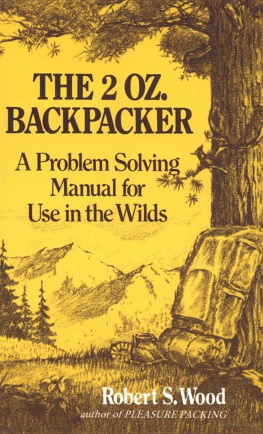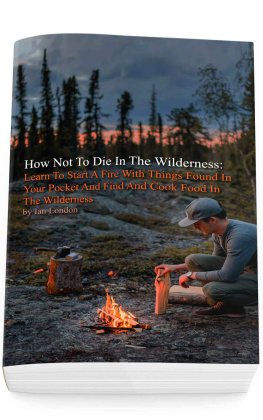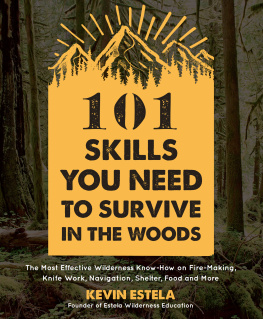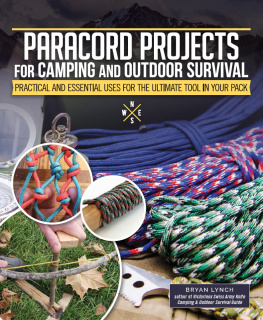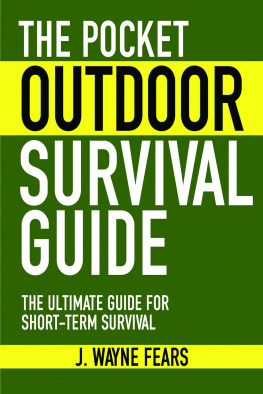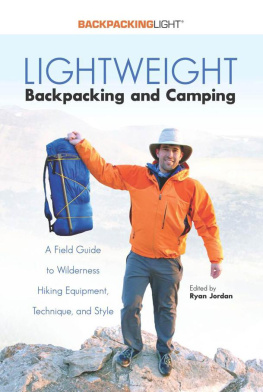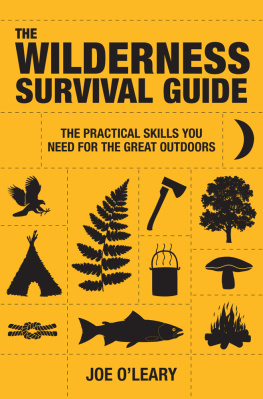Other Ten Speed Press Books
by Robert S. Wood
PLEASURE PACKING (The Classic)
DAYHIKER
ABOUT THE AUTHOR
Long a tinkerer with backpacking equipment and a searcher after comfort in the wilds, Robert S. Wood has been walking and climbing for twenty-five years in the Sierra Nevada, the Cascades, Mexico, Europe, South America, New Zealand and Australia. He has written and edited for a number of magazines, including Time, Life, Sports Illustrated, Sierra Club Bulletin, Wilderness Camping and Outside.
Copyright 1982 by Robert S. Wood
All rights reserved. Published in the United States by Ten Speed Press, an imprint of the Crown Publishing Group, a division of Random House, Inc., New York.
www.crownpublishing.com
www.tenspeed.com
Ten Speed Press and the Ten Speed Press colophon are registered trademarks of Random House, Inc.
Library of Congress Catalog Number: 82-80236
eISBN: 978-0-307-81625-2
v3.1
For my mother,
Helen S. Wood
CONTENTS
ONE
Walking
TWO
Keeping Fit
THREE
Camping
FOUR
Cooking
FIVE
Navigating
INTRODUCTION
The 2 oz. Backpacker?
Readers have asked for a featherweight source book they can justify carrying along with them in the wilds, something that will provide a backup to their own experience, help them deal with adversity and ensure their getting the most from their trips.
Thats exactly what Ive tried to produce. This little book deals exclusively with situations backpackers encounter in wilderness. Here are the tips and techniques my friends and I use to sail along safe and easy in the wilds, staying out of trouble, getting the maximum pleasure and comfort from our trips.
Ive tried to cram all the data I can into a small, tough, flexible format on light, thin but high quality paper, aiming at a total book weight of just two ounces, so weight-conscious backbackers will carry it. If the printer failed to make the weight you can always rip off the covers or take scissors to the margins.
This is strictly a field guide. I have wasted no space on data that cant help you in the wilds. If you want to know how to choose the right gear, get in shape, travel light, select clothing, plan menus and trips, and understand how insulators, fabrics and the human body interact, get my Pleasure Packing for the 80s, also from Ten Speed. Its a soup to nuts, 255 page reference book on backpacking, but it weighs twelve ounces and isnt meant to be carried. Much of this little book has been distilled from its best selling big brother.
This isnt a survival booklet, either. A backpacker shouldnt need to know how to rub two sticks together for fire, flag down a passing plane, snare rabbits or cook without pots. Hes supposed to have all the essentials on his back and be prepared to travel through the country he has chosen to visit. This little book is to help you deal with discomfort, injury or other emergency. Its also to help you maximize your safety and minimize your worry, to provide an extra margin of safety. Think of it as you do emergency food, bandages, surplus matches and extra batteries. You hope you wont need them, but you dont dare leave them home!
Ive tried to organize my material for easy access, so you can find what you need without reading the whole book. The chapter headings have been supplemented (both in the table of contents and at the head of each chapter) with an elaboration of whats contained. Headlines within the text match this elaboration to help you with equipment breakdown, unexpected weather, unfriendly campsites or a temporary loss of orientation. You can likewise find techniques to help you wring the most pleasure from your precious vacation.
Even if you dont get in trouble twenty miles from nowhere, this little book will have its uses. The blank pages in back, used for notes, can double the pleasure of your next trip by reminding you what to leave home, what to bring more of and what to do differently. Or leave notes to your partner or a record in mountaintop registers. The text can supply escape reading on a rainy afternoon in the tent. It will even function as inferior toilet or cigarette paper, or excellent firestarter after a rain. Or you can prop up the stove with it, patch a hole in your boot or insulate your bottom while sitting on cold rocks. And if youre desperate enough it can even be boiled in salted water to make a low calorie broth.
Whatever uses you find for this little book, I hope it helps you to a happier, safer trip when youre deep in the wilds with only the pack you carry on your back.
Bob Wood
Walker, California
March 1982
ONE
Walking

This little book is meant to be carried with you in the wilds, to help you out when you need help, cheer you up when youre tired and make you more comfortable. I sincerely hope you find what you need.
A backpackers ability to walk efficiently, safely and comfortably is absolutely vital to a happy trip. And walking well is no joke when you must make your way through wild country, often on steep and difficult terrain, under widely varying weather conditions, sometimes at high altitude, carrying everything you need on your back. Fortunately, there are ways to make wilderness travel a lot easier, safer and more fun.
There is a myth that one should find a comfortable pace and then stick to it. Nothing could be farther from the truth. The most common error among hikers is trying doggedly to maintain a set pace despite changes in the grade. Constant speed is an impossible goal. Comfortable, efficient walking depends on maintaining ones energy outputnot ones speedat a level which will not produce excessive fatigue. This simply means slowing down when the trail climbs, then speeding up when it levels off.
The length of ones stride should also be variable. When the trail suddenly grows steeper, I not only slow down, I take shorter steps. When the trail levels off, my stride gradually lengthens. Walking in this manner, i.e. trying to maintain an even and comfortable output of energy rather than trying to maintain a constant speed, I am never forced to stop from exhaustion, and I log more miles per day in greater comfort.
Theres a scientific basis for my variable speed philosophy. Specialists have determined that for every individual and set of walking conditions there is an ideal pace, an optimal speed which requires minimal energy per step. Our internal computer instinctively tries to conserve energy and it will govern our speed for maximum efficiencyif we let it! Ignoring the clockwork within ourselvesby hurrying and even by moving too slowlywill be far more tiring than the optimal pace because its using more energy than necessary.
Finding an Ideal Pace
Since every individual will have a different ideal speed, group travel presents certain problems. A 52 lady complained, My 63 boyfriend, who is normally very thoughtful, spent a lot of time on our backpacking trip bawling me out for being slow, clumsy and lazynone of which I am if Im accepted at my size and weight. It took me three steps for every two of his. Her boyfriend complained about his 40 pound pack, though it was only 20% of his weight, while she struggled to keep up carrying 25 pounds, fully 25% of her hundred pound weight. This couple was trapped into a mutually unhappy situation by his failure to understand their different physical capacities and by the less obvious but more common assumption that they had to travel togetherwhich means at the same speed.
Next page
